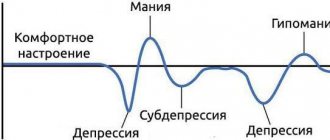This disorder was talked about loudly several years ago, when Catherine Zeta Jones was diagnosed with bipolar disorder on living with bipolar disorder in Catherine Zeta-Jones.
Catherine Zeta-Jones
actress
Millions of people suffer from this, and I am only one of them. I say this loudly so that people know that there is no shame in seeking professional help in such a situation.
Largely thanks to the courage of the black-haired Hollywood diva, other celebrities began to admit that they were experiencing this psychosis: Mariah Carey Mariah Carey: My Battle with Bipolar Disorder, Mel Gibson, Ted Turner... Doctors suggest Celebrities With Bipolar Disorder bipolar disorder in those who have already died famous people: Kurt Cobain, Jimi Hendrix, Ernest Hemingway, Vivien Leigh, Marilyn Monroe...
The listing of names familiar to everyone is only necessary to show that psychosis is very close to you. And perhaps even you.
What is bipolar disorder
At first glance, there's nothing wrong with it. Just mood swings. For example, in the morning you want to sing and dance with the joy of being alive. In the middle of the day, you suddenly lash out at your colleagues who are distracting you from something important. By the evening, a severe depression rolls over you, when you can’t even raise your hand... Sound familiar?
The line between mood swings and manic-depressive psychosis (this is the second name of this disease) is thin. But it is there.
The worldview of those who suffer from bipolar disorder constantly swings between two poles. From an extreme maximum (“What a thrill it is to just live and do something!”) to an equally extreme minimum (“Everything is bad, we’re all going to die. So, maybe there’s nothing to wait for, it’s time to commit suicide?!”). The highs are called periods of mania. The lows are periods of depression.
A person realizes how stormy he is and how often these storms have no reason, but he cannot do anything with himself.
Manic-depressive psychosis is exhausting, worsens relationships with others, sharply reduces the quality of life and can ultimately lead to suicide.
Diagnostics and therapy
Manifestations of bipolar syndrome are not always promptly diagnosed due to the correspondence of its symptoms to other mental disorders. To correctly make a diagnosis, a certain period of observation of the patient is necessary: this makes it possible to make sure that there are manic attacks and depressive manifestations, and that they are cyclical.
To identify the disease, it is necessary to consult a specialist, where a clinical conversation will be held, including questioning and examination of the patient, study of anamnestic data, both subjective and objective (from relatives), and diagnostic testing using screening scales and self-questionnaires. Thorough examinations may be required - tomography, laboratory blood tests, ultrasound, study of hormonal profiles. This will allow us to determine the presence of physical pathologies, cancerous tumors, and malfunctions of the endocrine system. Diagnosing bipolar disorder requires an integrated approach. It involves collecting as much information as possible about the patient, as well as analyzing the duration of his behavioral disorders and their severity. It is necessary to observe the patient, make sure there are no physiological pathologies, drug addiction, etc.
Timely determination of the clinical picture and development of a treatment strategy guarantees a positive result in a short time. The modern techniques available in their arsenal can effectively combat attacks of psychosis, extinguish them, improve the quality of life and social adaptation of the patient.
Where does bipolar disorder come from?
Mood swings are familiar to many and are not considered something out of the ordinary. This makes bipolar disorder quite difficult to diagnose. Nevertheless, scientists are coping with this more and more successfully. In 2005, for example, the Prevalence, Severity, and Comorbidity of Twelve-month DSM-IV Disorders in the National Comorbidity Survey Replication (NCS-R) found that about 5 million Americans suffer from manic-depressive illness in one form or another.
Bipolar disorder is more common in women than in men. Why is not known.
However, despite a large statistical sample, the exact causes of bipolar disorders have not yet been clarified. What is known is that:
- Manic-depressive psychosis can occur at any age. Although it most often appears in late adolescence and early adulthood.
- It may be caused by genetics. If one of your ancestors suffered from this disease, there is a risk that it will come knocking on your door.
- The disorder is associated with an imbalance of chemicals in the brain. Mainly serotonin.
- The trigger is sometimes severe stress or trauma.
Where does extreme pedantry come from?
Pedantry is a character trait that many acquire over time. In other cases, pedantry takes a rather extreme form, the pedant obsessively cleans, organizes, puts everything on shelves or in alphabetical order. The displacement of anything can be the cause of fuss and great anger of the pedant, who, while giving orders, shows indignation.
Psychologists have noticed that pedantry can be hereditary, for example, when a person adopts a penchant for pedantry from his parents. It can also be "inherited" by modeling or observation. A pedantic mother can teach her child a passion for order by cleaning almost every free minute. Manic pedantry can also have a psychological basis, for example, it can be a symptom of increased anxiety and a desire to control one's life.
The pedant experiences anxiety when chaos reigns around him, and he is often susceptible to a pathological sense of control if there is chaos in his life (personal, emotional, professional).
How does a pedant behave? Is this just cleaning? Of course, cleaning and organization are his area of expertise; he loves to arrange everything, wash, wipe, and make sure that there is order around him. This is often how manic pedantry manifests itself in women. Pedantry in men is also expressed in excessive meticulousness, for example, things are always neatly hung in the closet, the purse is in order, shoes are folded on one shelf, the car is parked in a certain place. When something needs to be done differently, for example, if a parking space is occupied, then men experience a feeling of discomfort, fear, and anger.
How to Recognize Early Symptoms of Bipolar Disorder
To detect unhealthy mood swings, you first need to find out whether you are experiencing emotional extremes - mania and depression.
7 Key Signs of Mania
- You experience elation and a feeling of happiness for long periods (several hours or more).
- Your need for sleep is reduced.
- You speak quickly. And so much so that those around you do not always understand, and you do not have time to formulate your thoughts. As a result, it is easier for you to communicate in instant messengers or via emails than to talk to people in person.
- You are an impulsive person: you act first, think later.
- You are easily distracted and jump from one thing to another. As a result, bottom line productivity often suffers.
- You are confident in your abilities. It seems to you that you are faster and smarter than most of those around you.
- You often exhibit risky behavior. For example, you agree to have sex with a stranger, buy something you can’t afford, or take part in spontaneous street races at traffic lights.
7 Key Signs of Depression
- You often experience prolonged (several hours or more) periods of unmotivated sadness and hopelessness.
- You become isolated in yourself. You find it difficult to come out of your shell. Therefore, you limit contact even with family and friends.
- You have lost interest in those things that used to really captivate you, and have not gained anything new in return.
- Your appetite has changed: it has sharply decreased or, on the contrary, you no longer control how much and what exactly you eat.
- You regularly feel tired and lack energy. And such periods continue for quite a long time.
- You have problems with memory, concentration and decision making.
- You sometimes think about suicide. Catch yourself thinking that life has lost its taste for you.
Manic-depressive psychosis is when you recognize yourself in almost all the situations described above. At some point in your life you clearly show signs of mania, at another you show symptoms of depression.
However, sometimes it happens that the symptoms of mania and depression manifest themselves simultaneously and you cannot understand which phase you are in. This condition is called mixed mood and is also one of the signs of bipolar disorder.
Mental disorders
If we briefly and clearly describe what pedantry is, it can manifest itself in a tendency to control the behavior of others. The pedant loves to command, give orders, wants everyone to work the way he wants. The pedant is a perfectionist, he is a thorough, even boring person. Disturbances irritate him greatly and often drive him crazy. This may push other people who are surrounded by a pedant to become pedantic.
Excessive pedantry can also coexist with many other mental disorders. Pedants may be anal, have obsessive-compulsive disorder, or suffer from holistic personality disorders, including autism and Asperger's syndrome.
What is bipolar disorder?
Depending on which episodes occur more often (manic or depressive) and how pronounced they are, bipolar disorder is divided into several types Types of Bipolar Disorder.
- Type 1 disorder. It is severe, alternating periods of mania and depression are strong and deep.
- Disorder of the second type. Mania does not manifest itself very clearly, but it covers with depression just as globally as in the case of the first type. By the way, Catherine Zeta-Jones was diagnosed with exactly this. In the actress’s case, the trigger for the development of the disease was throat cancer, which her husband, Michael Douglas, had been battling for a long time.
Regardless of what type of manic-depressive psychosis we are talking about, the disease in any case requires treatment. And preferably faster.
Anal personality
Pedantry is one of the core symptoms of a personality disorder called anal personality. It was named so by Sigmund Freud. The traits of such a personality are stubbornness, honesty, and obsessive maintenance of cleanliness. A person with this disorder is stubborn, characterized by rigidity in thinking and acting. Has a penchant for petty pedantry, excessive organization of everything, is economical, and has a poor mind. He is too suspicious of others, quickly gets irritated, reacts impulsively and may show an increased tendency to aggression. Unfortunately, he also has a tendency towards dictatorial behavior and likes to boss others around. Often a narcissistic and gloomy person. He is characterized by a passion for collecting objects and is good at individual jobs, including artistic professions. This type of person always brings things to the end. People of this type have excellent memory. If you remember something, then for the rest of your life. They have a lot of phone numbers and jokes stored in their heads.
General developmental disorders
Mania for organizing everything can also be a symptom of holistic developmental disorders, including autism and Asperger's syndrome. The first symptoms of these diseases are observed already in childhood and even infancy and are not difficult for parents to see. It seems unusual to them that a child puts toys in a certain order and gets nervous when someone rearranges them. In addition, the baby can set up his own ritual of fun, do everything in a strictly defined way and only in the order known to him. These types of symptoms may be typical of a child, but may also indicate the need for in-depth diagnosis. If in doubt, you should contact children’s specialists: a child psychologist, a neuropsychiatrist. They will conduct psychodiagnostics, help determine the degree of pedantry, and, if necessary, prescribe correction or treatment.
Pedantry and obsessive-compulsive disorder
Excessive pedantry can be a symptom of obsessive-compulsive disorder (OCD). This condition consists of two types of symptoms. The first is obsessions or obsessive thoughts that interfere with normal existence. They are caused by anxiety, a core feature of the disorder. The second symptom is compulsion, which is a compulsion that a person does to get rid of an obsession, such as worry, so he cleans the bathroom again because he thinks that if he doesn't something will happen to his child. it's bad when he goes there. Another example of pedantry combined with OCD: you need to go or go to work in the same way as it was done before, because if you choose a different path, an accident or other trouble will occur.









